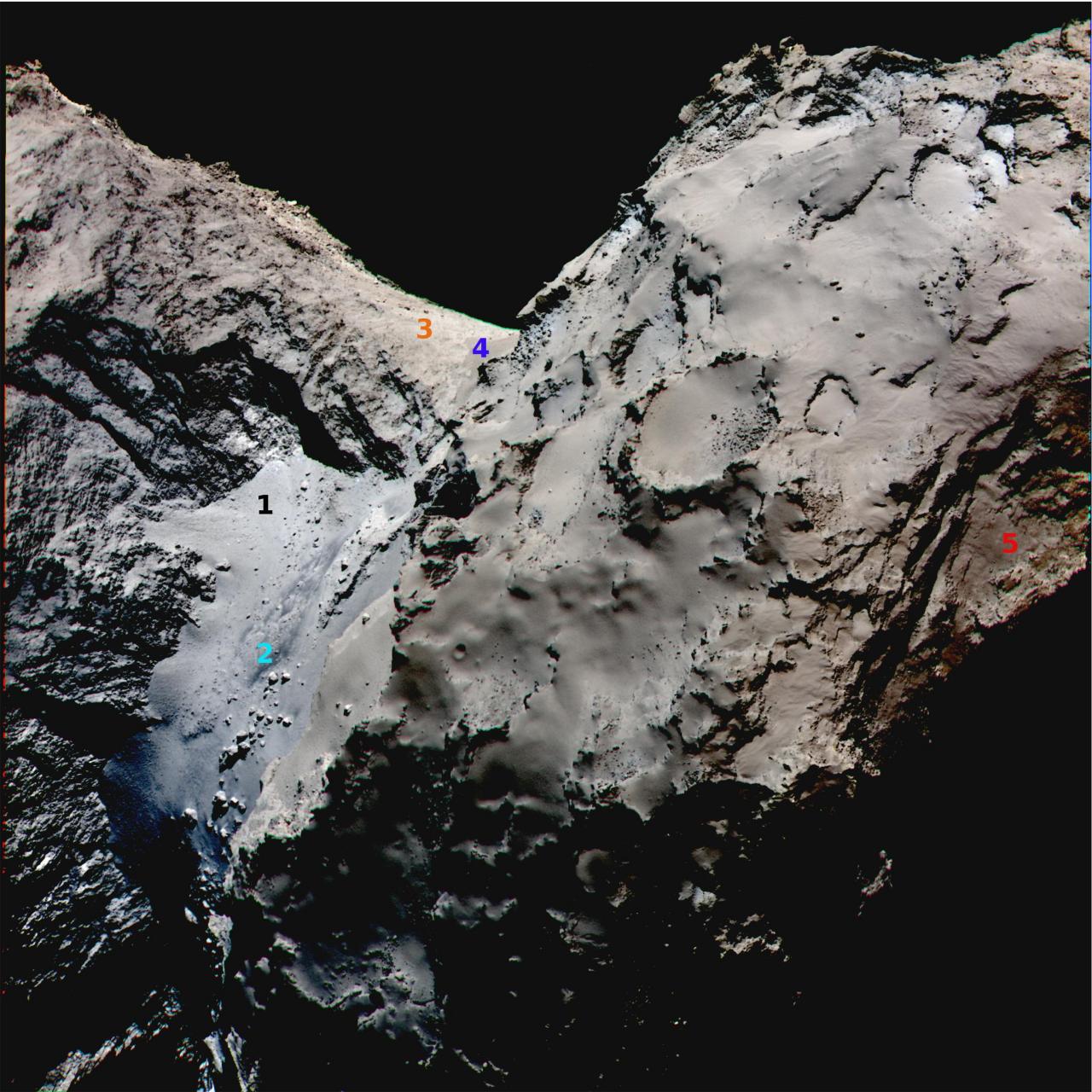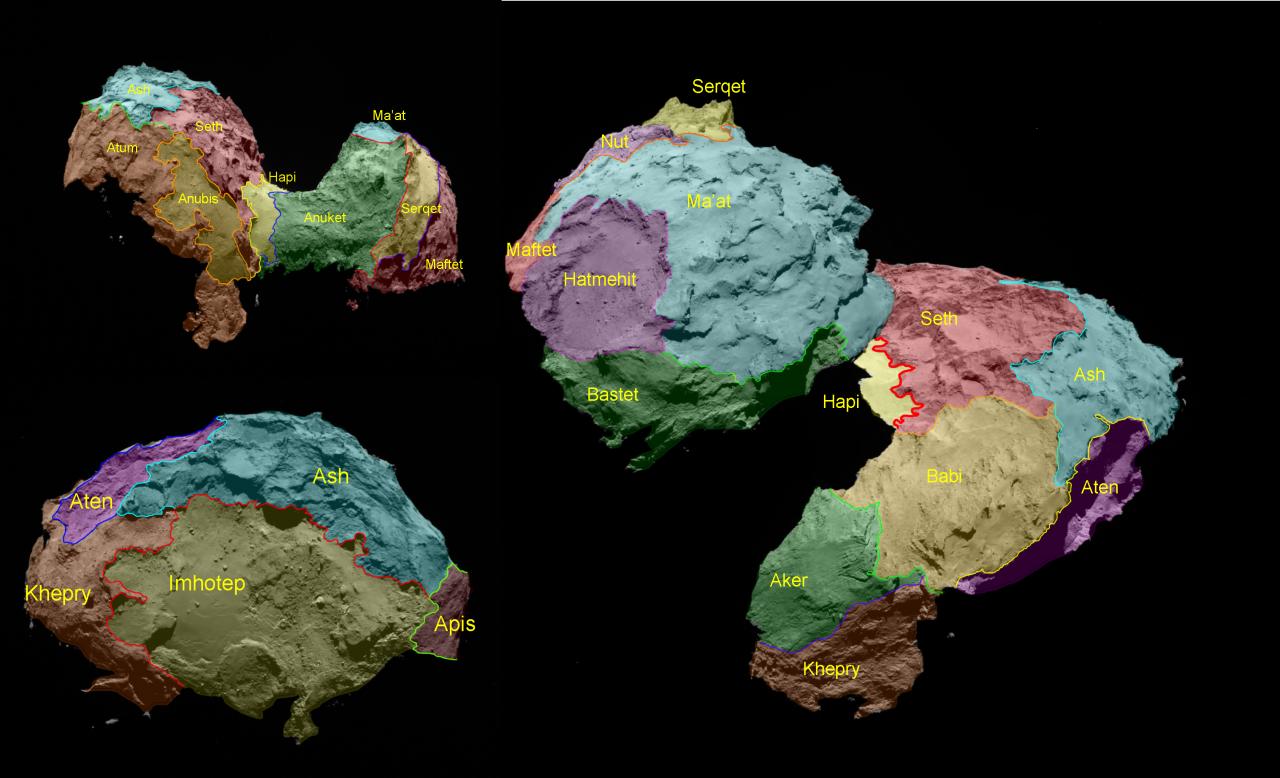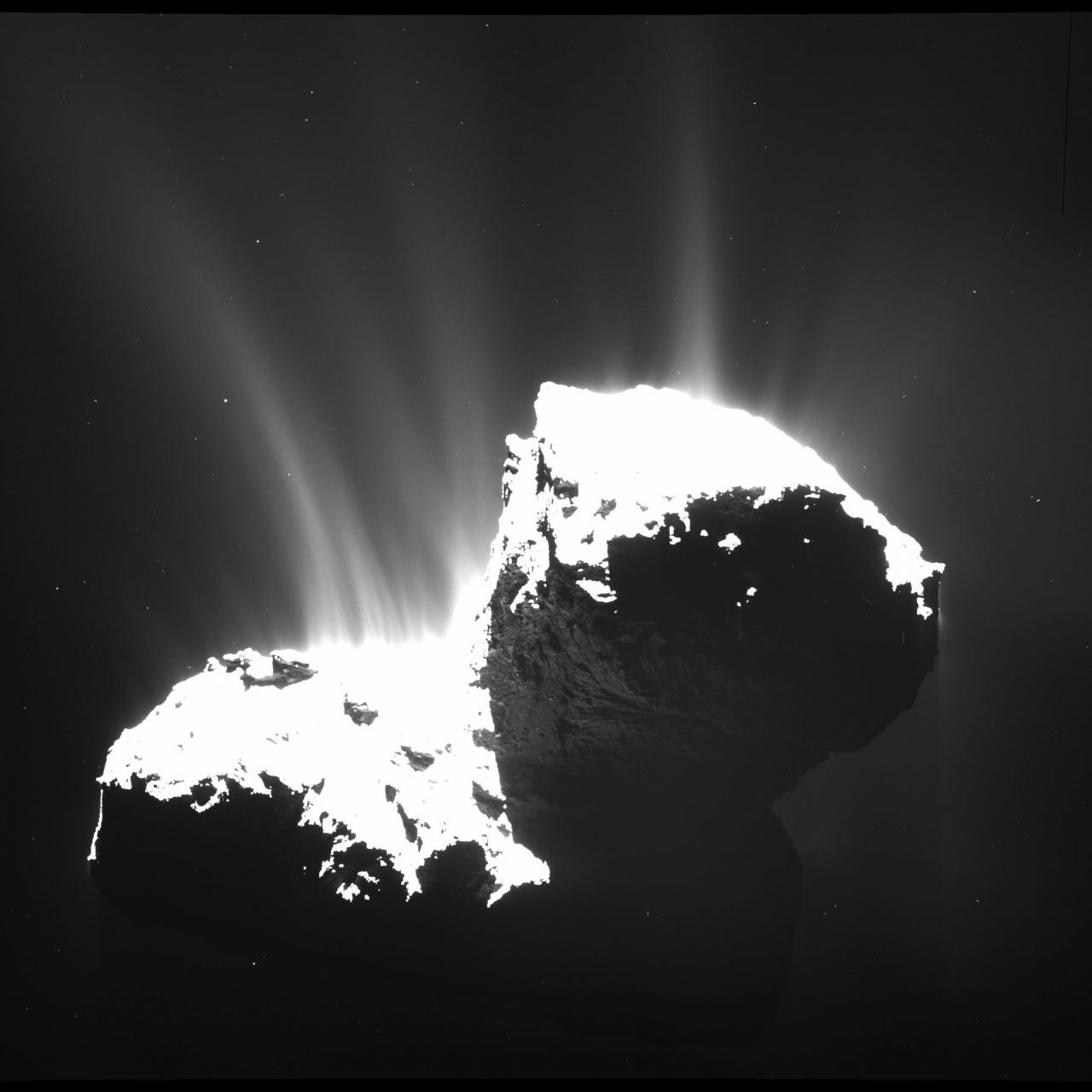Rosetta mission yields most accurate and integral picture of a comet ever
Science magazine publishes special edition on findings of Rosetta, on orbit around comet 67P Churyumov-Gerasimenko since August 2014
The Rosetta mission (ESA), travelling toward internal regions of the Solar System on orbit around comet 67P, is yielding the best data ever obtained about the nucleus of a comet. The data are being used to determine the comet’s density, for the first time directly, as well as to describe in detail the different regions on its surface and to study the origin of the activity on its envelope (coma) and tail.
Researchers at the Institute of Astrophysics of Andalusia (IAA-CSIC) and the Centre for Astrobiology co-wrote three of the published articles which analyze the structure and activity of the comet, its morphological diversity and the characteristics of the dust on its envelope from data yielded by the OSIRIS camera and the GIADA instrument.

Detail of the nucleus. Credit: ESA/Rosetta/MPS for OSIRIS Team MPS/UPD/LAM/IAA/SSO/INTA/UPM/DASP/IDA.
According to Pedro J. Gutiérrez, researcher at IAA-CSIC involved in the mission, "Comets can help us understand the genesis of the Solar System as well as the origin of earthly water, but first we must answer key questions about these bodies which until now could only have been answered by landing on one, because once they become active and observable from planet Earth their nucleus is blotted out by the coma”.
One of the fundamental questions about comets has to do with the internal structure of their nuclei, which implies knowledge of their density, a magnitude we knew so far only from indirect estimates. The Rosetta mission has been able to directly measure the density of 67P: it is half as dense as water and, given its size, must be 80% empty.
"Now we must figure out if that void is due to micrometric pores or great cavities, a question linked to the formation of comets, the answer to which will also allow us to determine whether comets are really primary bodies in the evolution of the Solar System,” says Luisa M. Lara, researcher at IAA-CSIC and member of the OSIRIS team, responsible for the optic system aboard Rosetta.
A SHAPE NEVER SEEN BEFORE
Images from OSIRIS have made it possible to analyze in detail the shape of 67P, whose bilobate structure reminiscent of a rubber duckling might indicate that the comet originated in the fusion of two objects or, on the contrary, that the region between the lobes (also known as the “neck” of the comet) is a product of erosion. After the first results that question remains open; it will be answered by the data obtained from Rosetta in the course of the year.
The high resolution of OSIRIS, which picks up on details only decimeters long, has revealed an unexpected morphological variety on 67P’s surface. To date, for lack of accurate images of certain areas of the southern hemisphere, nineteen distinct regions have been classified on the nucleus of the comet. Named after Egyptian mythology, they are grouped into five basic categories: fields covered with dust, fragile material with pits and circular structures, great depressions, smooth surfaces and areas of consolidated material.

Map or the comet. Credit: ESA/Rosetta/MPS for OSIRIS Team MPS/UPD/LAM/IAA/SSO/INTA/UPM/DASP/IDA.
"The complex morphology of 67P points to the existence of different processes that shape the surface: there are fractured regions, dune-like structures presumably resulting from the transport of dust, and zones, like Aten, which seem to result from sudden voluminous loss of material,” says Rafael Rodrigo, researcher at the Center of Astrobiology (CAB, CSIC-INTA) involved in the mission.
That level of complexity for a body only four kilometers long is extraordinary. It is generally due to the episodes of activity triggered by moments of proximity to the sun.
ACTIVITY SOONER THAN EXPECTED
Activity on comets is triggered by proximity to the Sun. The ice on the comet sublimates and ejects dust, thus conferring to the nucleus – otherwise similar to a ball of dirt and snow – the appearance characteristic of comets: the coma and the tail.
The Rosetta mission, which will follow this transformation on comet 67P from a vantage point, has yielded surprises on this count also, revealing signs of activity at a distance of more than six hundred million kilometers from the Sun (more than four times the distance between the Earth and the Sun), much farther than was expected. To date, the activity on 67P stems mainly from the neck, where several jets of dust have been observed, although minor centers of activity have also been spotted on the lobes.

Dust jets emerging from the comet nucleus. Credit: ESA/Rosetta/MPS for OSIRIS Team MPS/UPD/LAM/IAA/SSO/INTA/UPM/DASP/IDA.
Dust analysis carried out by the GIADA instrument has made it possible to distinguish, apart from particles ejected through the jets, a cloud of particles orbiting around the nucleus. Moreover, the ratio of dust to ice, which in models tends to be even, has turned out to be lopsided: the dust contains between two and six times more dust than ice.
"The measures taken by GIADA, at a distance three times that between the Earth and the Sun, a place where the activity of the comet is very low, have demonstrated the impeccable performance of the instrument and substantiate our hopes of magnificent results from now on, when the comet increases its activity and thereby its particle emission,” José Juan López Moreno, IAA-CSIC researcher involved in developing the instrument, concludes.
A. Rotundi et al. Dust Measurements in the Coma of Comet 67P/Churyumov-Gerasimenko Inbound to the Sun Between 3.7 and 3.4 AU. Science Express
N. Thomas et al. The Morphological Diversity of Comet 67P/Churyumov-Gerasimenko. Science Express
H. Sierks et al. On the nucleus structure and activity of comet 67P/Churyumov-Gerasimenko. Science Express
Instituto de Astrofísica de Andalucía (IAA-CSIC)
Unidad de Divulgación y Comunicación
Silbia López de Lacalle - sll[arroba]iaa.es - 958230532
http://www.iaa.es
http://divulgacion.iaa.es

